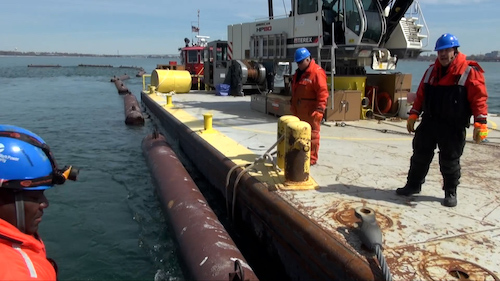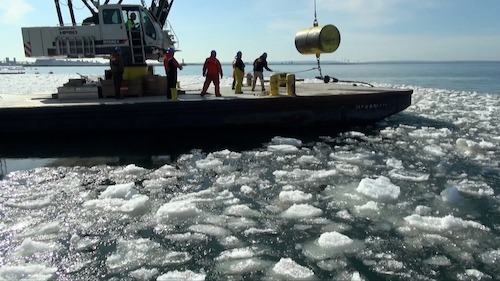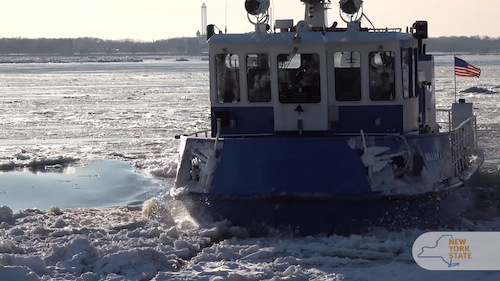Every year in late November or early December, media outlets in and around Buffalo, N.Y., report on the installation of a huge ice boom at the head of the Niagara River. For good reason, too. Without the arch and the IBEW members who install it, the entire region could be in harm's way.

|
The boom’s installation is an annual event in western New York and ensures that ice flows do not interfere with service at two hydroelectric plants that provide 25% of the state’s power.
Credit: New York Power Authority.
|

|
|
Local 2104 members installing a steel pontoon that will make up a small part of the ice boom.
Credit: New York Power Authority.
|

|
The William H. Latham, a 77-ton icebreaker, is sometimes used by the New York Power Authority to make repairs on the ice boom. It is named after a former NYPA engineer who presided over the Niagara hydroelectric project.
Credit: New York Power Authority.
|
The boom has been installed every year since 1964. It forms a natural ice arch that reduces flooding and jams at two New York Power Authority hydroelectric plants, which provide power to about 25% of the state. Any disruption would be catastrophic in an area known for extreme winter weather.
Work begins when the water temperature falls below 39 degrees or Dec. 16, whichever comes first.
Yet, despite the amount of coverage, little is known about the people doing the dangerous work aboard a small barge. High winds are common. Low visibility often is a problem. Plus, the barge is sometimes just one mile from Niagara Falls, which has a vertical drop of more than 160 feet at its highest point.
The barge crew members are the best at what they do and serve their communities at the highest level. Thus, it's no surprise they are members of Niagara Falls, N.Y., Local 2104, which represents NYPA employees in western New York.
Many utility employees routinely perform work in dangerous conditions, but Business Manager Lou Fazzolari said the crew of 12 to 14 workers take it to another level.
"What they do for the electric grid of New York is invaluable," Fazzolari said. "They do a job in the harshest conditions imaginable, 24 hours a day in the worst weather. You can't say enough about them."
Fazzolari described the men — as of now, they are all men, although women have been on crews in the past — as "common, everyday people doing amazing work." He added: "Everyone comes from such diverse backgrounds from different crafts. You have welders, auto mechanics, you name it — and they're all willing to do the work."
That sounds like an apt description of Tom Reynolds.
"Realistically, it's a challenge," he said. "Throughout my career, I always pursued challenges."
Reynolds started as a pipefitter before joining Local 2104 after he was hired by NYPA in 2011. One year later, he joined the boat crew installing the boom as a barge mechanic. He was promoted to engineer in 2017.
He compares the work to what someone might see on "Deadliest Catch," the Discovery Channel series on crab fishing off the Alaska Coast.
Water crashes over the boat. Crew members wear helmets and flotation devices in case they slip. But they do not wear harnesses because it impedes their work while they try to insert a three-inch pin into a 120-pound pontoon.
The primary tools are battery-powered impact guns and hydraulic torque wrenches. They make a socket connection on each end of a 500-foot cable. One end is attached to the lake bottom. The other is attached to the steel pontoons, which are 30 feet long and 30 inches in diameter. About 110 are used to construct the boom.
A crane helps, but crew members still are handling anywhere from 20 to 200 pounds in often miserable weather conditions. Keep in mind that this is in and around Buffalo, where the temperature is routinely well below freezing.
"We do this with a lot of crane assistance," Reynolds said. "But a lot of it is with brute force and ignorance."
When finished, the boom stretches about 8,800 feet — almost two miles — across the outlet of Lake Erie. It is anchored to the bottom of the lake by steel cables that are 2½ inches wide. It is removed by April 1 of the following year as water warms and the level rises.
"The biggest thing is the job is completely dangerous," Reynolds added. "You have unknown forces involved. When you have an ice field that is 500 square miles pushing up against your steel cables, there is no real way to determine how much pressure that is."
Yet Reynolds proudly notes that the crew has never had a catastrophic injury.
"Everyone understands this is not done by one person," he said. "We're put together like a beautiful team. Everyone knows their part, we move very quickly, and you know you have to depend on your union brother right next to you."
Trevor Ganshaw began working on the boom after being hired by NYPA 21 years ago. He's a second-generation IBEW member and now the lead captain, out giving instructions to the rest of the crew.
When he started, Ganshaw said, he was struck by the uniqueness of the work. Not only was it like unlike anything else at NYPA, but it involved running a cable between two countries, the United States and Canada.
Now, it's just part of his yearly routine and something he takes immense pride in.
"Let's face it, there are personal differences on every job, where people can't get along," Ganshaw said. "But when you're out there, you have to be in sync with the guys around you. Those times when a cable breaks and something jumps out of the way, you have to act. You have to take care of each other."
Fazzolari said women have worked on crews in the past. A female mechanic apprentice applied for a position but will have to undergo the required training before joining a crew.
Even by the region's standards, western New York had a pretty brutal 2022-2023 winter. Nearly 52 inches of snow fell on the city during a four-day storm just before Christmas. More than 40 deaths were attributed to it. That followed a major storm earlier in December.
But the crews installing the boom got most of their work done without a hitch. Ganshaw said work was slowed one day because snow had to be cleared off the barge. Other than that, it was a smooth installation season.
"The weather was very cooperative," he said. "We had some of those 70 [mph] winds and we thought the boom might have issues and break apart. But we secured the boats and the lines, and we didn't have any trouble."
As one might expect, there are some financial incentives to working on the boom. Crew members get an 8% pay premium and routinely receive overtime during the process, which takes about 12 days if the weather is cooperative, Reynolds said.
But the value of the work goes far beyond that. Crew members know they are not only doing vital work for the region but are also helping to keep Lake Erie — a key part of a shipping route that stretches from Chicago to the St. Lawrence Seaway to the Atlantic Ocean — open during the winter.
Plus, pulling into Buffalo Harbor and seeing the city's downtown all lit up on a cold winter's night isn't a bad way to end a hard day's work, Reynolds said.
"When you're done and it's successful, you feel a unique sense of accomplishment with all the guys out there," he said.